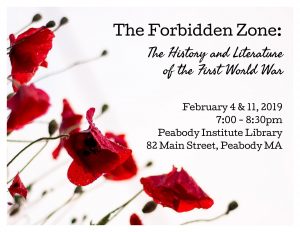Those of you who attended the first week of our two-week book discussion on Mary Borden’s The Forbidden Zone were treated to a lively discussion about the kind of stories we tell about the First World War, and how they shape the way we think about history and what we can learn from a given moment in time.

As was pointed out last night, the traditional narrative of The First World War tells us that the war was ugly and disillusioning and utterly, totally futile. That it’s only value lies in the fact that it led to the Second World War. But in reality, that narrative obscures the critical importance of the First World War to a significant number of historic events, movements, and developments. To take just a few examples, our language evolved as a result of the war. Phrases like “binge drink”, “blind spot”, and “pushing up daisies” all entered the vernacular between 1914 and 1918. The rise of women employed in industry, mechanics, and technical jobs rose significantly, if only for the duration of the war. But the result was that a significant number of women received training for new kinds of work, were exposed to new people, and learned a new kind of self-reliance. In the United States, Black men and women enlisted in a number of positions, and worked on the home front, leading to a change in national demographics, but, more importantly, a renewed fight for civil rights across the country. Some of the medical advancements made during the war remain with us today, from plastic surgery to burn treatments.
And so, with that in mind, we wanted to share some book recommendations for those looking to read some new stories about the First World War that get away from the narratives of the War Poets and traditional narratives that stick with us regarding the war. We hope you enjoy!
The Forbidden Zone: Mary Borden was born in Chicago, but was living with her husband in London when the war broke out. When the Red Cross turned down her offer to buy them a hospital, she built, funded, and staffed a hospital on her own, and worked there as a volunteer nurse for the duration of the war. This book is a collection of her reminiscences, memories, and experiences of war service, written largely while she was at the front. As a result, this is a collection of stories about the women who lived behind the front lines, and how they survived the war, about the colonial troops who served for the British and the French armies, about the kind of wounds she treated, and the moral and physical challenges of caring for soldiers in war, knowing you were healing them to go back and fight further. Structurally, the book is a modernist masterpiece, show that the modernist form of writing was not in anyway exclusive to the men in the trenches.
Three Comrades: Erich Maria Remarque is perhaps best known for his novel All Quiet on the Western Front, but his later works are also sensational, and drive home the lasting effects of the war, not only on veterans, but on the societies as a whole that had to endure the war. This book, written during the rise of Hitler and his National Socialist Party, tell of three war veterans, and the woman with whom one of them falls in love. It’s a tragedy, and it’s a hauntingly beautiful study of the melancholy and loss that its main characters are all suffering after the war, and in the world it left behind. It’s also a deeply moving story of friendship and love that counters the narratives of brutality and anger that are so often found in stories from the trenches.
 The Forty Days of Musa Dagh: The First World War was not only a European war–it was one that truly encompassed the world, and Austrian novelist Franz Werfel shares one of the darkest parts of the war in this novel, based on true events. The story was inspired by the self-defense by a small community of Armenians living near Musa Dagh, in the Ottoman Empire (the area is part of current-day Turkey), and recounts the events of the Armenian Genocide, which began within the context of the war, with perpetrators using the chaos of war to hide and justify their actions. Werfel continued to rewrite and update the book after its first publication in response to the rise of the Nazi party, and the persecution of people within Werfel’s own life. The Armenian Genocide is a critically important aspect of the First World War, but this book also documents the Genocide itself, and sheds light on how states and people shift their language to dehumanize groups within its own borders.
The Forty Days of Musa Dagh: The First World War was not only a European war–it was one that truly encompassed the world, and Austrian novelist Franz Werfel shares one of the darkest parts of the war in this novel, based on true events. The story was inspired by the self-defense by a small community of Armenians living near Musa Dagh, in the Ottoman Empire (the area is part of current-day Turkey), and recounts the events of the Armenian Genocide, which began within the context of the war, with perpetrators using the chaos of war to hide and justify their actions. Werfel continued to rewrite and update the book after its first publication in response to the rise of the Nazi party, and the persecution of people within Werfel’s own life. The Armenian Genocide is a critically important aspect of the First World War, but this book also documents the Genocide itself, and sheds light on how states and people shift their language to dehumanize groups within its own borders.
